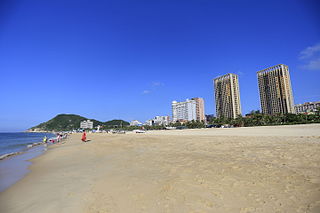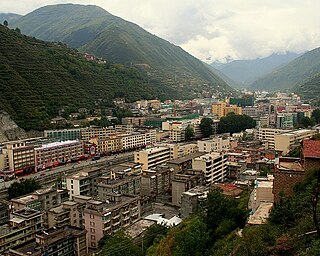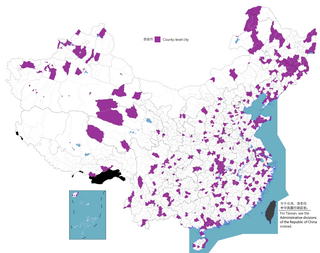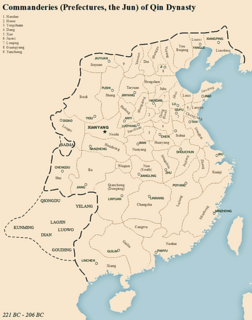
Shaoguan is a prefecture-level city in northern Guangdong Province, China, bordering Hunan to the northwest and Jiangxi to the northeast. It is home to the mummified remains of the sixth Zen Buddhist patriarch Huineng. Its built-up or metro area made up of Zhenjiang and Wujiang urban districts was home to 688,229 inhabitants at the 2010 census, Qujiang district not being conurbated yet.

Karamay is a prefecture-level city in the north of the Xinjiang Uyghur Autonomous Region, People's Republic of China. The name of the city comes from the Uyghur language, and means "black oil", referring to the oil fields near the city.

Gyézil County, also Jiulong County ; is a county located in southeastern Garzê Tibetan Autonomous Prefecture, Sichuan province, People's Republic of China. With a population of 52 thousand, mainly Tibetans, Hans, and Yis, it contains 1 town and 17 townships.

Heze, formerly known as Caozhou, is a prefecture-level city in southwestern Shandong, China. It is home to 8,287,693 inhabitants, of whom 1,346,717 live in the built-up area around the seat of government in Mudan District. The westernmost prefecture-level city in Shandong, it borders Jining to the east and the provinces of Henan and Anhui to the west and south respectively.

Wúzhōu, formerly Ngchow, is a prefecture-level city in the east of Guangxi Zhuang Autonomous Region, People's Republic of China.

Yuncheng is the southernmost prefecture-level city in Shanxi province, People's Republic of China. It borders Linfen and Jincheng municipalities to the north and east, and Henan and Shaanxi provinces to the south and west. At the 2010 census, its population was 5,134,779 inhabitants, of whom 680,036 lived in the built-up area made of Yanhu District.

Yangjiang, formerly romanized as Yeungkong, is a prefecture-level city in southwestern Guangdong Province in the People's Republic of China. It borders Maoming to the west, Yunfu to the north, Jiangmen to the east, and looks out to the South China Sea to the south. The local dialect is the Gaoyang dialect, a branch of Cantonese. During the 2010 census, its population was 2,421,748 inhabitants of whom 1,119,619 lived in the built-up and largely urbanized area comprising Jiangcheng District and Yangdong County.

Pingliang is a prefecture-level city in eastern Gansu province, China, bordering Shaanxi province to the south and east and the Ningxia Hui Autonomous Region to the north. Pingliang is well known for the nearby Kongtong Mountains, which are sacred to Taoism and location of the mythical meeting place of the Yellow Emperor and Guangchengzi, an immortal.

Lüliang or Lyuliang is a prefecture-level city in the west of Shanxi province, People's Republic of China, bordering Shaanxi province across the Yellow River to the west, Jinzhong and the provincial capital of Taiyuan to the east, Linfen to the south, and Xinzhou to the north. It has a total area of 21,143 square kilometres (8,163 sq mi) and total population of 3,727,057. The metro area of Lüliang has a population of 320,142 at the 2010 census.

Jinghe County as the official romanized name, also transliterated from Uyghur as Jing County, is a county of the Xinjiang Uyghur Autonomous Region and is under the administration of the Börtala Mongol Autonomous Prefecture. It contains an area of 11,181 square kilometres (4,317 sq mi). According to the 2002 census, it has a population of 120,000.

Huailai is a county in northwestern Hebei province, People's Republic of China, under the administration of the prefecture-level city of Zhangjiakou.

Barkam or Markang or Muerkvua is a county-level city in Ngawa Tibetan and Qiang Autonomous Prefecture, in the northwest of Sichuan province, People's Republic of China. The city seat is the town of Barkam.

Nancheng is a county of eastern Jiangxi province, People's Republic of China. It is under the jurisdiction of the prefecture-level city of Fuzhou. Historically it has been known as Jianchangfu (建昌府).

Qingyuan Manchu Autonomous County, or simply Qingyuan County (清原县) is one of the three counties under the administration of the prefecture-level city of Fushun, in the east of Liaoning, People's Republic of China, and is also one of the 11 Manchu autonomous counties and one of 117 autonomous counties nationally. It has a population of about 340,000, covering an area of 3,921 square kilometres (1,514 sq mi).

Fujin is a county-level city in the east of Heilongjiang province, People's Republic of China. It is under the jurisdiction of the prefecture-level city of Jiamusi.

Gangca County is a county of northeastern Qinghai province, China, on the northern shore of Qinghai Lake. It is under the administration of Haibei Tibetan Autonomous Prefecture.

Tongde County is a county of Qinghai province, China. It is under the administration of Hainan Tibetan Autonomous Prefecture.
Xingren is a county-level city of southwestern Guizhou province, China. It is under the administration of the Qianxinan Buyei and Miao Autonomous Prefecture.

Youyu County, also known by its Chinese name Youyuxian, is a county under the administration of the prefecture-level city of Shuozhou, in the northwest of Shanxi Province, China. It borders Inner Mongolia to the north and west.

Wuzhai is a county of northwestern Shanxi province, China. It is under the administration of Xinzhou City.





























